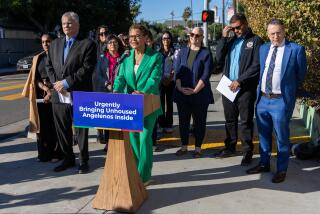Opinion: Did Occupy L.A. leave a legacy? Just look beyond the City Hall lawn
Remember this moment? Eric Garcetti (when he was L.A. City Council president) walked out to the lawn in front of City Hall and proclaimed to a sea of tent dwellers: “Stay as long as you need, we’re here to support you.”
It was three years ago last Saturday that Garcetti uttered those words to the denizens of Occupy LA. In the weeks after that, Antonio Villaraigosa, then the mayor, passed out 100 ponchos to rain-soaked occupiers. The City Council considered canceling the city’s business agreements with socially suspect banks, resurrecting then-Councilman Richard Alarcon’s responsible banking proposal. When the city administrative officer, Miguel Santana, told the council that such a move could cost the city millions of dollars in fees, Alarcon scoffed that he was “out of sync with the social dynamic.”
Of course, now Garcetti is the mayor, Alarcon is out of office (and recently convicted of voter fraud) and there is a sense that Occupy L.A. was a short-lived phenomenon. It arrived late to the national movement and left last -- sent packing by a surgical police strike early on the morning of Dec. 1, 2011. Its legacy seemed to go no further than a relandscaping of the tattered grounds of City Hall Park and the planting of a large sign explicitly forbidding camping and other transgressions.
But that’s the wrong takeaway. There is a legacy -- it’s subtle and still evolving. No, the occupiers didn’t get a moratorium on bank foreclosures in Los Angeles. But locally and across the nation, the Occupy movement has transformed social action.
How could we forget its most profound impact: In a country that prides itself on having no class distinctions, the Occupy movement made it acceptable, even urgent, to talk about the nearly insurmountable gulf between the rich and most everyone else, and gave us a new vocabulary -- the 1% and the 99% -- that we’re still using.
That shift in the tone of public debate helped rain down condemnation on Mitt Romney for his infamous 2012 remark about the 47% of Americans who felt the government owed them a living. And it, no doubt, helped make economist Thomas Picketty’s book “Capital in the Twenty-First Century,” a 696-page analysis of wealth and inequality, as hot a read as “Gone Girl.”
I think the most significant and influential offshoot of the Occupy movement is the Strike Debt organization, which was put together by activists -- including academics -- mainly from the Occupy Wall Street movement. In 2012, their Rolling Jubilee campaign set out to raise funds to buy debt on the secondary and tertiary markets -- where debts are sold for pennies on the dollar.
Generally, companies buy this kind of debt from other companies and then try to extract payments from the debtors. In this case, the point was to buy up the debt and abolish it, wipe it out, tell people they were freed from their debts and debt collectors.
The philosophy behind this idea is that much of the back-breaking, high-interest debt that people find themselves saddled with is for medical needs, housing or student loans.
The campaign’s goal was to raise $50,000. It raised $700,000. With those funds, organizers first wiped out $15 million in medical debt. Last month, they announced that they had bought and abolished about $4 million in student debt -- specifically the debt of 3,000 students from the for-profit Everest College, part of the ailing Corinthian Colleges Inc., which is being sued by the U.S. Consumer Financial Protection Bureau for allegedly operating an illegal predatory lending scheme.
Organizers would now like to focus on going beyond specific fundraising actions and creating a debtors collective that would have more power as a group than as individuals.
“People should not have to go into debt for their most basic needs -- housing, medical care, education,” said Hannah Appel, an economic anthropologist at UCLA who was involved in Occupy and is now involved in this movement.
Former Occupy Wall Street activists also marshaled their network of occupiers to provide aid, food and other goods to communities hit by Hurricane Sandy on the East Coast. The so-called Occupy Sandy operation mobilized as fast as some of the traditional nonprofits.
In L.A., the Occupy encampment wasn’t made up of just dope-smokers and homeless people who (understandably) found the grounds of City Hall a safer haven than the streets of skid row. Nurses, graduate students, ministers, progressive activists who participated in Occupy L.A. (whether they slept there or not) came away energized and took their resolve into other organizations.
It is that legacy that is still being formed. Some former Occupiers are involved in the local Stop LAPD Spying Coalition that has protested the use of warrantless drones by the Los Angeles Police Department. Others got involved in the Raise L.A. coalition to raise the hotel minimum wage. Some have gotten involved in neighborhood councils.
“Part of that activism was lit on fire by Occupy,” said Dick Price, who along with his wife, Sharon Kyle, edit and publish the L.A. Progressive and were regulars at the Occupy L.A. encampment. They didn’t expect Occupy to transform society in a matter of months. “The movement to shift power away from the 1% and make the country more economically equitable takes a long time,” Kyle said.
The point, here, I think, is that three years later, Occupy may have had less effect on policy than it did on political engagement. The tents may be gone, but there are plenty of Occupiers who became activists for various causes -- some more promising than others. But if Occupy inspired even a small wave of social activism, that’s not a bad trade-off for some damaged lawn.
Follow the Opinion section on Twitter @latimesopinion
More to Read
A cure for the common opinion
Get thought-provoking perspectives with our weekly newsletter.
You may occasionally receive promotional content from the Los Angeles Times.







